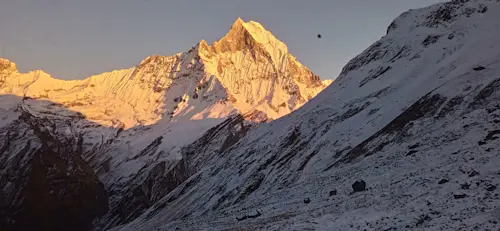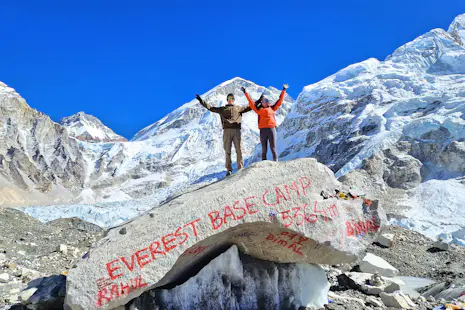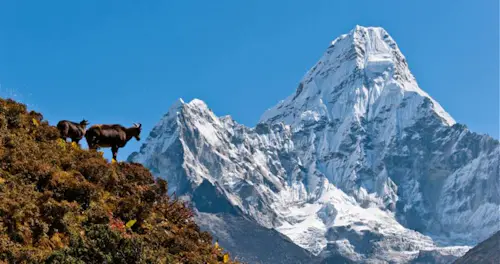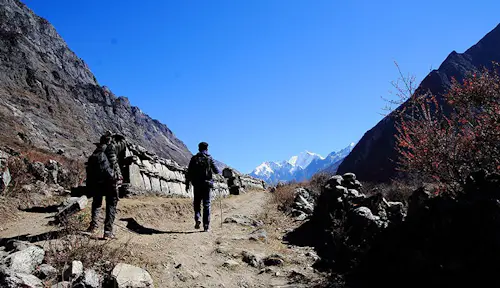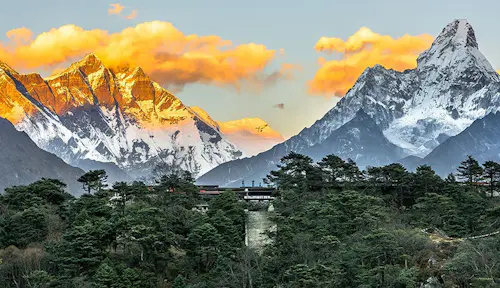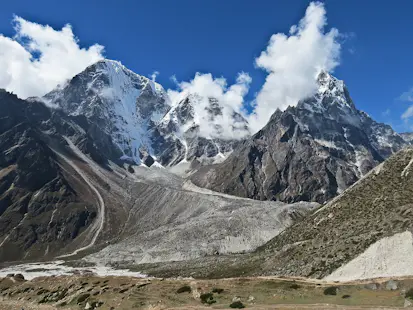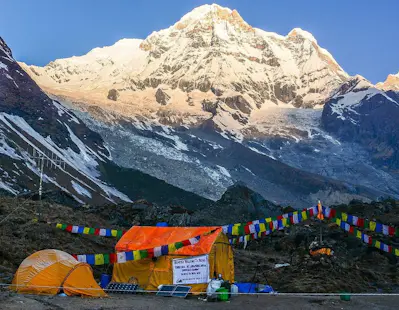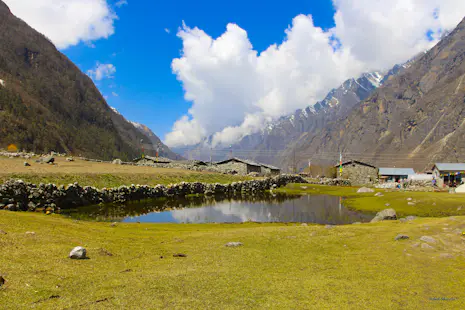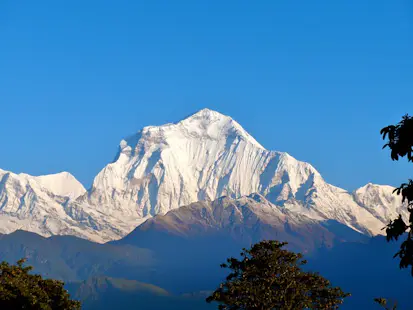
Classical Jiri to Everest Base Camp Trek in 20 Days
The certified guides from Sherpa Expedition and Trekking will lead you on this classical Jiri to Everest Base Camp trek over 20 days, as you traipse and travail along the most famous and well-trodden path to base camp, taking in the memorable scenery and cultural delights of the region.
TRIP TYPE
Group
MOUNTAIN RANGES
Himalaya
DURATION
20 Days
OFFER PERIOD
Mar - May, Sep - Nov
FITNESS LEVEL
Extremely Fit
SKILL LEVEL
Advanced
PAYMENT METHODS
Credit Card, Wire Transfer and more!
- Trek to the base camp of Mt. Everest - the highest mountain on earth!
- See the sunrise over Everest from Kalapatthar at 5,550m!
- Admire the vast, epic and dramatic scenery of the Himalayas
- Visit and learn about the traditions and culture of the local communities
Description
Description
This trip I will guide you on is one of the most famous, traditional and classic treks one can undertake in Nepal, as we wind our way along the truly epic and awesome Jiri to Everest Base Camp trek, passing by and through landscape, scenery and terrain such as terraced hillsides, lovely riverbanks and lush green forests, with the pay-off being the immensely satisfying achievement of reaching the base camp of Mt. Everest.
Mt. Everest is one of the most famous places on earth, owing to its status as the highest mountain on earth, standing at 8,848m tall. It remains one of the great bucket-list items for many, with thousands of people tackling both the base camp and summit each year.
Our trip begins when we meet in Kathmandu, and day 2 is when we transfer to Shivalaya to begin the trekking.
The subsequent 13 days consist of tough trekking each day, approximately 5-7 hours at a time, at increasingly high altitudes.
We stop and go through places such as Phakding (2,600m), Tengboche (3,860m) and Dingboche (4,460m), with the vast and dramatic scenery, Buddhist monasteries and small villages and communities making for a memorable setting.
There will be 2 in-built acclimatization days on the trek, in order to help stave off the effects of high altitude.
Days 15 and 16 are the focal point and undoubted highlight of the trip, as we reach the Everest Base Camp. A great sense of satisfaction will wash over us when we reach this point, and seeing the sunrise from Kalapatthar provides us with sweeping panoramic views of the mighty and majestic Mt. Everest, a moment that lives long in the memory for many.
The last 4 days of the trip are spent heading back to Kathmandu, where our trip ends, weary and satisfied at having accomplished something truly special and great.
Book now to experience one of the best treks one can ever do!
Price includes
Price includes
- Accommodation included
- Guiding fee
- Breakfast
- Lunch
- Dinner
- Local flights
- Transportation start and back
- Transport during the trip
- Luggage transfer
- Permit and entrance fees
- Group porters
- Personal porters
- Mountain guide expenses
- Camping equipment sleeping bag
Price details
Price does not include: all meals in city or the capital, travel insurance, international airfares, visa fees, alcoholic drinks, cold drinks, hot drinks, chocolate, laundry, wifi, personal trekking equipment, certain entrance fees, tips.
Secure your spot with just 25% payment
48-hour free cancellation with 30-day advance booking
Itinerary
Itinerary
Day 1: Kathmandu
We complete our custom formalities at the Tribhuwan International Airport in Kathmandu. Afterward, there is a Sherpa Expedition and Trekking representative waiting for us at the gate who will take us to our hotel. We can then spend the rest of the day taking rest. In the evening, we get to try Nepalese cuisine at a welcome dinner hosted by Sherpa Expedition and Trekking. Overnight in Kathmandu.
Day 2: Shivalaya
Morning drive along with Kathmandu/Kodari (overland Tibet entry point) highway in the beginning 3 hours and cross-Sun Koshi river toward Mude(3540 m) following crumble ascended bumpy road. It’s a scenic drive along with the terraced field, typical villages and panoramic view of eastern Himalayan including Ganesh Himal, Langtang Lirung, Dorje Lakpa, and many more snow-capped ranges. Finally, along the picturesque bus journey arrives a little riverbank town Shivalaya. Overnight at Hotel in Shivalaya.
Day 3: Bhandar
From Shivalaya the route crosses a stream, then starts a steep climb toward the next pass Sangbadanda at 2150m) Climb continue less steeply pass several isolated, but large and prosperous houses. The trail climbs steeply in the forest to another tea shop at Mabhir, cross another stream and the final climb to pass at 2705m Deurali. This pass signifies now we are entering an area donated by Tibetan culture because of an impressive array of long mani wall including beautiful mountain range though on distance. There is a sweeping view of the Likhu Khola valley and Bhandar, a large Sherpa settlement far below in a hanging valley. The trail drops about two hours to arrive our day destination Bhandar. Overnight at Hotel in Bhandar.
Day 4: Sete
From the village square of Bhandar, the trail descends through the lower fields of the village, then follows a small stream. It crosses the stream and descends through deep forest. Leaving the forest, the trail drops into a canyon, passing Barandas, where local kids sell walking sticks to help you out on the steep descent toward another riverbank little Sherpa town Kenja. (1570m) The trail ascends steeply toward Lamjura pass, the first part of ascending is very steep, then it becomes less severe as you gain elevation. After about two hours of climbing, you reach Chimbu, at 2140m. There is a trail junction, take right-hand fork to Sete. Overnight stay at Hotel in Sete.
Day 5: Junbesi
It’s a long day, but fairly gradual climb although in spots it gets steep from Sete to the top of Lamjura Pass (3530m) The way is scenic and varied through the rhododendron, magnolia, maple and birch forest long ranges of the Himalayas on the background. In spring the ridge is alive with blooming rhododendron – white, red and pink blooms over the entire hillside. The day also delightful for a bird lover, some of the most colorful ones are found in this zone. Since you probably are crossing the pass about noon or early afternoon, it will be cloudy, cold and windy. The route descends down the steeply eastern side of the pass about 400 m through fragrant fir and hemlock forest to the stream and small wooden Hotel. The trail climbs again to the huge painted mani wall at the head of the valley, then climbs over the ridge to a vantage point overlooking Junbesi a splendid Sherpa village amidst beautiful surroundings at 2680m.
Day 6: Trakshindu
With its attractive lodges and bazaar atmosphere, Junbesi is a good place to take a rest day and there is some interesting sidewalk to Buddhist monasteries in the surrounding hills. Away to the north, Number (6959m), known in Sherpa as Shorong Yul Lha (god of Solu), over the large green valley. In the middle of Junbesi, the Tashi Thongmon Gompa is founded in the sixteenth-century butt the monastery building destroyed several times by fire. By the large yellow- topped Stupa in the middle of the village, the Junbesi school is one of the largest Hillary school, with more than 300 pupils attending classes primary to higher secondary. In the opposite direction, the valley of Junbesi Khola runs toward Thubten Choling monastery (300m)a large Tibetan monastery founded by the revered Trulsuk Rinpoche who fled to Nepal from Rongbuk Gompa in Tibet with large group Anis (nuns)and monk in the 1960s. Since then, many more refugees have fled to Thubten Choling en-route to join the Dalai Lamaat Dharmashala in India. It makes worth to visit either before lunch or after on the rest day.
Day 7: Puritan
From Trakshndu the descends continues to Dudh Koshi (milk river), cross the large suspension bridge then trail ascends through terraced field and yard of houses Jubing a Rais settlement to Khari Khola at 2010m. From Khari Khola, you can see your next destination a cluster of building above on the ridge Bupsa. The trail descends from the village and crosses the Khari Khola on a suspension bridge near some water-driven mills at 1930m, then makes a steep climb to Bupsa(Bushing) at 2300m. Overnight at Hotel in Bupsa.
Day 8: Phakding
Today, our trail climbs steadily, but gently, through a forest inhabited by monkeys. Climb to the ridge, pass mani wall, which has the view of Mt. Khumbila and Mt. Cho Oyu (8201m) Keep climbing up to a cliff in the rock, then into another canyon on the ridge at 2840 overlooking Paiya (Chitok) a Sherpa settlement completely surrounded by forest at 2720m. from the ridge, the trail turns almost due east as it descends into the deep canyon of Paiya Khola. The trail climbs up and down for an hour after Paiya toward small tributary next to Dudh Koshi at 2290m Surkhe. After Surkhe trail climbs about 15 minutes to trail a junction where stone staircases on the right lead to Lukla and north up the steep canyon leads to Chauri Kharka a large green Sherpa village at 2630m. A gentle flat trail along the middle of the village encounters another trail from Lukla to Everest Base camp. The trail continues along the side of the Dudh Koshi valley passing villages and crossing Thado Koshi before to Ghat Overnight stay in Ghat.
Day 9: Namche Bazaar
After a nice morning, walk continues crossing bridges over Dudh Kosi River passing several interesting villages of Toc-Toc, Bankar and Monjo arriving at Sagarmatha National Park entrance gate, from here on the river bed for few hours and after the last bridge a steep uphill to Namche Bazaar, at Namche with facilities of good restaurant, pubs, cyber café, post office, and banks. Included meals: Breakfast, Lunch, and Dinner.
Day 10: Acclimitization
This is the first of the two days set aside for “acclimatization”. Health experts recommend us to stay active and moving during the rest day too instead of being idle. We either spend the day taking a day’s hike to Thame or visiting Khunde or relaxing and exploring Namche Bazaar itself. Namche Bazaar is the main center of the Everest (Khumbu) region and has government offices, ATMs, Internet cafes, shops, restaurants, a bakery, and a colorful market each Friday evening and Saturday. If we trek a few hundred vertical feet during the day, it will help us to properly acclimatize. Our guides take us to the Tourist Visitor Center near the headquarter of the Sagarmatha National Park where we can observe an assortment of things related to the first Everest ascenders, Sherpa culture and learn about the various plant and animal life of the Everest region.
Day 11: Tengboche
The trek continues along the rushing glacial waters of the Dudh Kosi with magnificent views of the mountains. We’ll have trekked to an altitude of 3,860 m upon reaching Tengboche. Inside the monastery are incredibly ornate wall hangings, a 20-foot sculpture of Buddha, and the musical instruments and robes of the Lamas. The group will be taken to observe a prayer ceremony either in the evening or in the morning depending on how the trekking goes this day.
Day 12: Dingboche
This stage is short, but as mentioned many will be doing it in the afternoon. The last hill into Dingboche is where the altitude often bites. Beware of too much activity on this first night. those merely strolling up from Pangboche should be fine. Leaving upper the routes heads to the village of Somare (4010m) and then Orsho; both have lodged. Later the path divides; the left path goes up to Pheriche. the trailheads around to a bridge, before a steep climb to the village of Dingboche (4410m), which has quite a few very good lodges.
Day 13: Acclimitization
It’s advisable to have another acclimatization day off before going higher. The best option is to hike up the valley to Chukkung (4730m) and on towards Island Peak (Imja Tes). Above Dingboche is Nagkartshang Gompa (allow 2-3hrsfor an energetic but short trip). or head to Pheriche for the HRA afternoon lecture on altitude sickness. The trail for Chhukung leaves Dingboche for the cluster of Bibr (4570m) is surrounded by fabulous Peaks: Taboche, the wall of Nuptse and Lhotse and the tremendous fluted cirque liking the Amphu Laptsa pass and Ama Dablam. Chukkung has several lodges and is a popular spot for that climbing island peak. Well acclimatized trekkers can head up a grassy slope towards the peak of Chukkung Ri (5550m) to view Makalu.
Day 14: Lobuche
After breakfast, we start with an easy walk towards Dugla. Next, we trek up the steep terminal moraine of the Khumbu Glacier, and then pass through the boulder-strewn slopes as we ascend Chupki Lhara where we find an array of stones with prayer flags used as memorials to Scott Fischer (American mountaineer) and 10-time Everest submitter Babu Chiri Sherpa (Nepalese mountain guide) who perished on a mission to climb Everest. The trail then continues to the Khumbu Glacier moraine and we find ourselves facing several great peaks – Khumbutse, Lingtren, Pumori and Mahalangur Himal. Overnight in Lobuche.
Day 15: Everest Base Camp
We take the trail to Everest Base Camp through the once vast Gorak Shep Lake. Continuing straight ahead, we come across the Indian army mountaineers’ memorials. The path from here can be misleading; hence it is important that we follow our lead Sherpa diligently. The walk is strenuous due to thin air in the high altitude. We pass through rocky dunes, moraine, and streams before reaching the Everest Base Camp. Upon reaching the Everest Base Camp, we see tents of mountaineers that stand out in bright colors against the monotony of gray surroundings (especially in the spring). Nuptse, Khumbuste, and Pumori are the mountains we can view from the base camp. We get back to Gorak Shep for a good night’s rest. Overnight in Gorak Shep.
Day 16: Kalapatthar
We prepare for an early morning departure, amid pre-dawn darkness and cold temperatures (-10 to -14 c). Plus, there is always the potential for chilly winds which are quite common. Familiar peaks such as Lingtren, Khumbutse, and Changtse tower to the east even as Everest begins to reveal itself. But, it is upon reaching Kala Patthar that we get to see360 degree up-close and formidable views of Mt. Everest. We take pictures, enjoy the magnificent mountain panorama, and then return back to Lobuche for a good night’s rest. Overnight in Pangboche.
Day 17: Namche Bazaar
From Pangboche we retrace our steps down to the Imja Khola and up through the forest to Tengboche. If interested, we can also visit nuns at the Tengboche monastery. After lunch at Tengboche, we continue through the hillside blanketed by rhododendron and juniper trees. After crossing the bridge over the Dudh Koshi River, our trail follows the Dudh Koshi gorge descending rapidly through the pine forests before reaching Sansa. We keep a lookout for wildlife such as mountain goats, snow leopards, colorful pheasants, etc., while passing through the forest. After passing a Chorten, we reach the army camp at Namche Bazaar. Overnight in Namche Bazaar.
Day 18: Lukla
This is our last day of trekking as we return to Lukla where the trek began. We enjoy this time to reflect on the trek as a group and the personal achievement of all those who took part. The afternoon is free, so you can wander about, relax and enjoy a hot shower! In the evening, have a few celebratory drinks and dance with your trek mates.
Day 19: Kathmandu
We catch an early morning flight to Kathmandu after our long mountain journey. After reaching Kathmandu, we can take a rest or do some souvenir shopping. If we want to explore any other areas of Kathmandu, we may do that today. Our guides can help you with both souvenirs shopping or sightseeing. There will be a farewell dinner in the evening to celebrate the climbers’ successful summit of the Island peak. Overnight in Kathmandu.
Day 20: End
Your adventure in Nepal comes to an end today! There is nothing to do but trade emails with your travel companions and organize your photos. A representative from Sherpa Expedition and Trekking will take you to the airport, approximately 3 hours before your scheduled flight. On your way home you’ll have plenty of time to plan your next adventure in the wonderful country of Nepal.
Details
Details
More info
Please bring with you:
- sleeping bag and down jacket
- duffle bag
- wind and weatherproof thin layered jacket -daypack
- warm gear for hands/ears/eyes
- warm trekking boots and socks
- sufficient clothing for upper, centre and lower body
- first aid kit and medicine
- trekking equipment
Meeting point
About the guide: Sherpa Expedition and Trekking
About the guide: Sherpa Expedition and Trekking

Sherpa Expedition and Trekking
4.50
(3)
Tour Operator
Languages
Russian | | Japanese | French | English | Chinese
What people are saying about Sherpa Expedition and Trekking
What people are saying about Sherpa Expedition and Trekking
Mesi
5.00
Join our newsletter!
Stay up-to-date on the best adventures.
